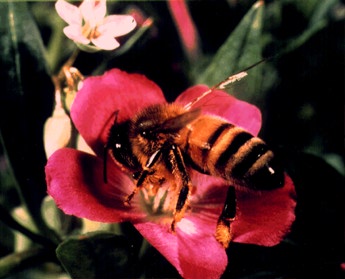INFORMATION SHEET 20
Stinging Insect Identification Tips
European Honey Bees:

- Are about one-inch long
- Are reddish brown with black encircling their abdomen
- Have a subtle striped appearance
- Have two sets of wings
- Have short hairs all over their body - even on their eyes
- The females can only sting one time and then dies
- The whole colony can live through the winter
- Build the inside of nest out of beeswax
- Are smaller than the bumble bee
- Eat nectar and pollen and make honey
- Have pollen baskets on their hind legs to carry food
- Do dances to tell other bees how far to fly for food
- Are not native to the U.S.; came from Europe
Africanized Honey Bees:
- Look just like any other kind of honey bee
- Are slightly smaller that the European honey bee, but only an expert can tell them apart
- Defend their hive more rapidly than the European honey bee
- Usually sting in greater numbers
- Are less selective about where they nest
- Swarm more often than European honey bees
- Do not have stronger venom than the European honey bee
- The females can only sting one time and then she dies
- Eat nectar and pollen and make honey
- Have pollen baskets on their hind legs to carry food
- Do dances to tell other bees how far to fly for food
- Are not native to the U.S.; came from Africa
Bumble Bees:
- Are relatively large and robust bodied
- Are yellow-and-black and have soft fine hair
- Have two sets of transparent wings with black veins
- Have pollen baskets on their hind legs to carry food
- Like to build their nest in the ground or in old bird nests
- Amply line their nests with moss and interwoven grass
- Are relatively unaggressive
- The females can sting more than once
- Do not use dances to "communicate " with other bees
Carpenter Bees:
- Are large and robust and resemble the bumble bee
- Are totally black in color
- Upper surface of abdomen is bald and shining
- Have powerful jaw muscles and strong mandibles that they use to bore tunnels into
dead trees or wooden buildings where they live
- Are solitary insects
- Are not likely to sting unless handled
- Have a surprisingly mild sting
Paper Wasps:
- Have a very thin waist
- Are brightly colored, smooth and somewhat shiny
- Have sharply contrasting black-and-yellow patterns
- Have two sets of dusky-colored wings
- Have narrow cylindrical legs and no pollen baskets
- Mandibles are used for biting and chewing
- Build their nest out of paper made from plant fiber or wood
- Like to position nest in a hollow tree, in the ground, or beneath the eaves of a house
- Are predators and eat insects and spiders
- The females can sting repeatedly
Yellow Jackets:

- Are a type of short, stocky wasp
- Have a cross-banded black-and-yellow abdomen
- The head and thorax are black with yellow spots and bars
- Have a broad abdomen that tapers off conically to a sharp point where the stinger is
concealed
- When not in flight, the wings are folded lengthwise down the middle and are held
slightly out to the side
- Are quick to attack when disturbed near their nest
- The females can sting repeatedly
- Like to nest in weedy brush areas on the ground or underground in an old animal
burrow or crevice


